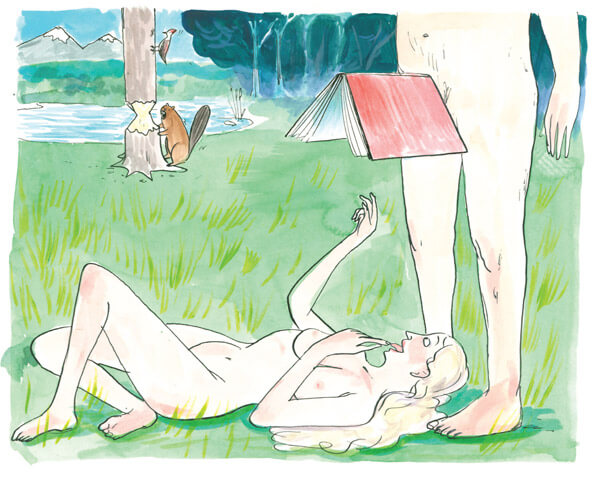Let’s Get It On
Darryl WhetterWebsite
Canadian fiction prefers the joinery of farmhouses — not farmhands
The preference among Canadian literary awards for historical fiction has created a national literature devoted to burlap sacking instead of life in the sack. The repeat shortlisting of historical fiction, in which a rural or foreign yesterday is somehow more important than today, contributes to our excessively chaste literature. England has just seen the release of In Bed With, an anthology of smut by respected female writers. Meanwhile, in their new book The Porning of America, literature professors Carmine Sarracino and Kevin M. Scott examine how the internet has made porn and sexuality mainstream (hello, YouPorn.com). Yet here in Canada we still have a fiction devoted to mill town sagas and multi-generational farm stories, few of them emboldened by sexuality.

Here in Canada we still have a fiction devoted to mill town sagas and multi-generational farm stories, few of them emboldened by sexuality. Illustration by Graham Roumieu
Mary Lawson’s 2003 Crow Lake manages to have a plot that turns on the consequences of sex, but prefers to devote its prose to marsh fauna and the joinery of farmhouses, not farmhands. Andrea MacPherson’s 2007 Beyond the Blue is literally set in a wartime burlap factory. In life, we flirt by email. In our literature, we go to barn raisings.
Several Canadian literary magazines have recently released so-called “sex issues.” Pick up these earnest journals and you’ll find plenty of writing devoted to pop culture and shades of afternoon light. Etymology will abound. But no one will actually have sex.
Counter to this trend of dour and sexless fiction is Russell Smith’s self-confessedly pornographic — and recently re-released — novel, Diana. Part dirty love letter, part cri de genitalia, and part satire, Diana has many layers. This urban coming-of-age story follows a twentysomething Toronto woman in and out of a few jobs and several more beds. The vicissitudes of the publishing industry meant the first edition had become hard to find, so when Biblioasis, a new Ontario press, began re-releasing important but out-ofprint Canadian books, Smith emerged from behind his female mask to re-release Diana with a frank new introduction. Smith rightly calls it “silly” that Canadians don’t write or read about sex, “that area of conflict and pleasure which is so central to our daily lives, our relationships, our self-confidence, our whole sense of self.”
Globe columnist and Governor General’s Award nominee Smith originally released the novel under the pseudonym “Diane Savage.” Although he now regrets having tried to pass off the first edition as the writing of a woman, that gender-bending was obviously more than just a desire to court the largely female market for erotic literature. Writing as a woman allowed Smith to investigate important issues of submission and dominance both freely and authoritatively. Diana is submissive in one relationship, then dominant in the next; this trajectory provides an honest and complex portrait of female sexuality.
More generally, however, our sexless national literature perpetuates North America’s gender double standard and is even more discouraging of lustful, pro-sex women. Popular fiction by Canadian women has recently forgotten about birth control, with Ami McKay’s The Birth House featuring a cover image of a woman who is headless, barefoot, and pregnant, and Leah McLaren’s The Continuity Girl, devoted to a “sperm bandit” in search of a big belly, not the big O. Not Diana. Not Smith. His sweaty chapters are a sexual decathlon, taking us through exhibitionism, BDSM, three-ways, phone sex, fetish-wear, and swinging.
Smith’s affectedly female voice is interesting and socially valuable, even if it isn’t always successful. He goes straight to the genitals on the first page, which is exactly counter to any advice I’ve ever received (couldn’t we start with the backs of the knees?). The original use of a pseudonym may also have made Smith too cautious. The penis is freely described with a varied schoolyard vocabulary, yet Diana‘s happy spot is often referred to as “her sex.”
The fact that sex is everywhere save our (subsidized) literature is more than simply misrepresentative. It’s also a lost opportunity to capitalize on one of fiction’s specialties — privacy. We often watch movies with someone else, whereas fiction is almost always read alone. Diana is actually quite funny, and humour is another thing often lost in our overly chaste literature. Mordecai Richler’s Barney’s Version was one of the last novels to win the Stephen Leacock Memorial Medal for Humour, and it’s full of sex.
If realism, social relevance, intimacy, and humour aren’t reason enough to up the porn quotient in CanLit, look at your thermometer. This is Canada. Is there a better way to keep warm in the winter?